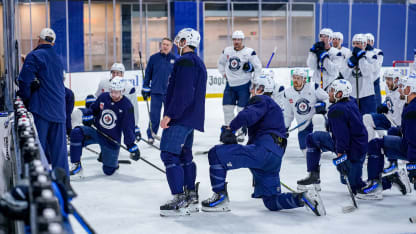ST. LOUIS - When Winnipeg Jets head coach Scott Arniel went over the video from Game 3, one thing stood out to him, and he made sure Saturday’s 35-minute practice focused on fixing it.
“We were a step behind St. Louis we really felt like for most of that first period,” Arniel said. “When we were doing things at a higher pace, a higher tempo, we end up changing the momentum of the game. They were doing that to us it seemed like more than us doing it to them.”
Of course, the Jets expected St. Louis to come out with a strong start in Game 3 in front of their home fans. Still, they felt their start could’ve been a lot better – specifically when it came to pace – and aim to play with far more speed to start Game 4 on Sunday.
“I think this year we’ve done a really good job of bouncing back after games we don’t like, coming back with a much better effort, dialing back into details and things like that,” said Jets captain Adam Lowry. “We need to try and get to our game quicker than they do. But I think the belief in this group is in the way we defend, the structure we have. We don’t have a record like we do without being able to bounce back, without coming into big games and rising to the occasion.”
Gabriel Vilardi just might be part of the group helping the Jets rise to the occasion.
The 25-year-old hasn’t played since suffering an upper-body injury on March 23 against the Buffalo Sabres. He had been wearing a non-contact jersey since April 20, but on Saturday he was a full participant in a regular jersey.
Arniel says Vilardi is a game-time decision.
“There is a possibility for him tomorrow,” Arniel said. “I haven’t really talked to the medical team yet… I have to talk to those guys and we’ll see where he’s at.”
Vilardi set a new career high with 27 goals, 34 assists, and 61 points in 71 regular season games. His 12 power play goals led the Jets, and his six game-winners were the third most.
The forward didn’t take line rushes in a regular spot, but did participate in a couple power play rotations. With no morning skate ahead of the noon puck drop at Enterprise Center, warm-up will be the best indication of whether Vilardi will play or not.
The line rushes at practice did have a small wrinkle, as Morgan Barron moved from his centre spot (with David Gustafsson and Jaret Anderson-Dolan on the wings) to the left wing alongside Adam Lowry and Mason Appleton.
The full rushes looked like this:
Connor-Scheifele-Iafallo
Niederreiter-Namestnikov-Perfetti
Barron-Lowry-Appleton
Tanev-Gustafsson-Anderson-Dolan
Morrissey-DeMelo
Samberg-Pionk
Stanley-Schenn
Fleury-Miller
Being on a line with Adam Lowry isn’t new for Barron. In fact, the two usually hop over the boards together following a Jets power play (depending on which power play unit finishes the man advantage), so there is plenty of familiarity between the two.
According to Natural Stat Trick, the duo has played 65:07 together at five-on-five, controlling just over 51 percent of the shot attempts and holding a 14-8 edge in high-danger chances generated.
"They have an identity. You guys know it, I know it, you can kind of see the way they want to play. To me, it's just jumping in and being a part of that,” Barron said of joining Lowry and Appleton. “It's being heavy, being physical. You never know what matchups you're going to get on the road, especially, but it's a line that plays against the other team's top line at times, and pretty much right down the lineup. So I'll just try to go out and do what I know I can do, bring speed, and be physical, and hopefully get in on the forecheck and create a bit more zone time for us."
Arniel said the move – if it’s used in Game 4 – has more to do with some of the match-ups the Blues were looking for against the Jets. It’s the next phase of the chess match that has been going on since the puck dropped on Game 1.
“You’re always trying to find something that might work in tomorrow’s game that maybe you didn’t try earlier,” said Arniel. “I think both teams will look to do things and get an edge. They had it the other night. Now we have to make sure we have the next one.”
And for the Jets, it all starts with speed and playing fast.
“When you’re slow and not up and running, it’s taking longer to get to that offensive zone and we don’t have the numbers and the bodies we usually need,” said Arniel. “I think if we’re going faster, cleaner coming out of our end, now we’re coming early on in shifts instead of later in shifts.”



















